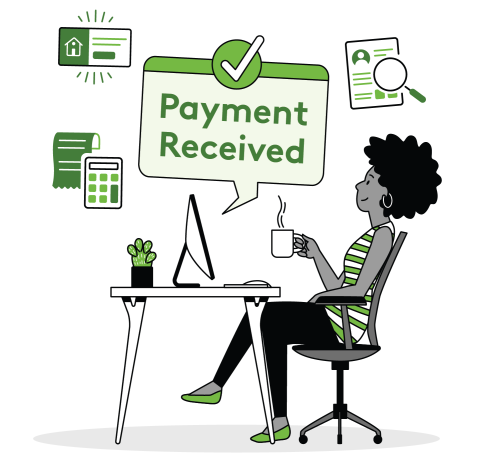
Understanding rental income is essential for landlords looking to make a profit and stay financially organized. Whether you’re a first-time landlord or just refining your strategy, knowing how to calculate rental income will help ensure your property’s profitability and potential.
To do this effectively, you need to know the different calculations involved, their definitions, and the metrics used to evaluate profitability. With this knowledge, you’ll be able to confidently calculate your rental income.
- What is cash flow?
- How to calculate rental income
- What is ROI?
- Sample calculation for rental income
- Tips for maximizing your rental income
What Is Cash Flow?
Cash flow is all the money you earn from your rental after you minus any expenses. To get your cash flow, you need to gather all the profit from your rental, like rent payments and any monthly fees you collect. Take that sum and subtract all the expenses from it, such as taxes, property management fees, utilities, operational costs, and mortgage.
You want a positive cash flow, meaning that your profits are greater than your expenses. This ensures your rental income covers your expenses as well as generating additional profit. You can use this profit any way you want, including saving it for renovations or obtaining another investment property to expand your portfolio.
How to Calculate Rental Income
There isn’t a single formula for estimating your rental income. Rather it is a collection of calculations that each gives you a different way to evaluate your rental’s profit.
The two main calculations that landlords use for calculating rent income are gross income and net rental income. Gross income refers to the total earnings from your rental before deducting any expenses.
On the other hand, net rental income is the income that remains after all expenses have been subtracted. Both are important as they highlight different aspects of your rental’s performance.
Calculate gross property cash flow
When calculating gross property cash flow, you need to add up all the sources of income related to your rental. This includes rent, fees, and any other sources of income related to the rental. If your property sat vacant at any time during the year you also need to account for that. A rent roll is a great source of data for the information you need to find your gross property cash flow.
Finding gross rental income
Before you can find your gross cash flow, you need to figure out a couple of other metrics. The first one is your gross rental income:
- Gross rental income = monthly rent amount × number of units × number of months
If you have two properties and charge $1,628/month, you’d do this calculation:
- 1,628 × 2 × 12 = 39,072
Getting your vacancy rate
Now it’s time to calculate the vacancy rate and your vacancy loss. The vacancy rate is the percentage of units in a rental property that are unoccupied. You need the vacancy rate to find the vacancy loss, which is the amount of income you lost due to vacancy. Finding the vacancy rate is easy with this formula:
- Vacancy rate = (number of days rental was vacant ÷ number of days property was available to rent) × 100
For example, let’s say you had a tenant who lived in the property for 330 days and the property was vacant for the last 35 days after their lease ended. To find the number of days the rental was vacant, you subtract 330 from 365.
- 365 – 330 = 35
Now divide the number of days the property was vacant (35) by the number of days the rental was available (365). Then multiply it by 100 to get the percentage.
- 35 ÷ 365 = 0.096
- 0.096 × 100 = 9.6
- So, the vacancy rate for your property was 9.6 percent.
Subtracting to get the vacancy loss
Once you have the vacancy rate, it is time to get the vacancy loss:
- Vacancy loss = gross rental income ÷ vacancy rate
Using the numbers above, you’d divide 39,072 by 9.6
- 39,072 ÷ 9.6 = 4,070
- Your vacancy loss is $4,070.
Adding additional income
You also need to gather and add up any additional income you have from your rental. This could be pet rent or any application fees. For the sake of the example, you earn an extra $30 a month from pet rent. Simply multiply that monthly additional income by 12 to find your annual additional income:
- 30 × 12 = 360
Calculating gross rental cash flow
Now that you have all your numbers, you can calculate the gross cash flow:
- Gross cash flow = (gross rental income + annual additional income) – vacancy loss
Taking the numbers from the previous examples here is what the formula would look like:
- (39,072 + 360) – 4,070 = 35,362
- Your gross cash flow for the year is $35,362
Account for operating expenses
On the flip side of getting your gross cash flow, you need to know the total amount of your expenses over the year. Common examples of rental expenses are:
- Mortgage payments
- Taxes
- Insurance costs
- Maintenance
- HOA fees
- Utilities
Here’s an example of what your expenses could look like if added up at the end of the year:
- Mortgage: $12,000
- Taxes: $2,400
- Insurance: $1,200
- Maintenance: $1,000
- HOA: no HOA
- Utilities: paid by renter
- Total expenses: $16,600
Understanding net operating income
Now that you have your gross cash flow and total amount of expenses, you can find your net operating income (NOI), also known as net rental income or net cash flow. It tells you how much profit you made from your rental after expenses. This is how you find your NOI:
- Net operating income (NOI) = gross cash flow – expenses
- 35,362 – 16,600 = 18,762
- Net operating income: $18,672
What Is ROI?
To determine your rental’s profitability, you need to calculate the Return on Investment (ROI). It is usually expressed as a percentage, where the higher the percentage, the better the investment. Use the ROI of your investment property to decide if you should keep operating the way you are or if there is anything you need to change.
How to calculate ROI
There are a couple of different ways to calculate the ROI depending on your situation. It’s best to start by using the basic ROI formula. Then you can tailor it to fit your needs.
To calculate your property’s ROI, all you need is your rental’s gross cash flow and the total purchase price.
- Return on Investment (ROI) = gross cash flow ÷ property cost/purchasing price
- Then multiply that number by 100 to get a percentage
Let’s say you purchased the property for $197,500. You would do this calculation:
- 35,362 ÷ 197,500 = 0.18
- 0.18 × 100 = 18
- ROI: 18 percent
What’s a Good ROI?
A good ROI is dependent on your goals as an investor. It can also be affected by how you financed your property, the location, and the market. Generally, a rental property ROI of 15 percent or higher is great. The higher the ROI percentage, the more return and profit you are getting. If you don’t have a great ROI, it might be time to shake things up and try something new to increase your rental income.
Sample Calculation for Rental Income
| Formula Name | Formula | Calculation Example | Total |
|
Gross Rental Income |
Monthly rent amount × number of units × number of months |
|
39,072 |
|
Vacancy Rate |
(Number of days rental was vacant ÷ number of days property was available to rent) × 100 |
|
9.6 |
|
Vacancy Loss |
Gross rental income ÷ vacancy rate |
|
4,070 |
|
Additional Income |
Sum of all additional income from rental over entire year |
|
360 |
|
Gross Cash Flow |
Gross rental income + annual additional income) – vacancy loss |
|
35,362 |
|
Operating Expenses |
Sum of all expenses over entire year:
|
|
16,600 |
|
Net Operating Income |
Gross cash flow – expenses |
|
18,672 |
|
ROI |
(Gross cash flow ÷ property cost) × 100 |
|
18 |
Tips for Maximizing Your Rental Income
If your ROI is a little lower than you like, don’t fret. Try these tips to see if you can increase your rental income.
Raise the rent
Raising the rent means you are earning more money from your rental. Make sure you are charging a rent that is in line with the market and comparable properties and not underselling your property. Rent Comp Reports on Apartments.com help you set the price by leveraging data-driven insights.
If you’re already in line with the market rate and want to raise the rent, try upgrading or renovating your property. This will increase your rental’s value and justify a rent increase. Depending on how much you want to increase rent by, you can start with something smaller like repainting the walls or go big and install granite countertops.
Find long-term tenants and reduce vacancies
Long-term tenants mean your property won’t be empty, so you don’t have to worry about any vacancy losses and get a steady source of income. Ensure the renter is a good fit by conducting proper tenant screening and encourage renters to rent long term by offering a lower rent for longer periods.
Charge additional fees
You can get a little more income without raising the rent by charging additional fees. This includes pet rent, parking fees, administration fees, and more.
Make Rental Income Tracking and ROI Analysis Effortless
Simplify your financial management with the Rental Income and Expense Tracker and Rental Property ROI Calculator — two powerful tools available on Apartments.com.
The Rental Income and Expense Tracker helps you to keep track of all the money going in and out in one place. There’s no need for manual calculations as the Income Statement Report summarizes your rental’s total net income, total gross income, and total expenses.
To assess your property’s profitability, dive in deep with the Rental Property Calculator. Explore key metrics like annual cash flow, NOI, cash-on-cash ROI, capitalization rate, and more. Simply enter details such as purchase price, down payment, and interest rate to get started.
FAQ
What are the tax benefits of owning a rental property?
One of the bonuses of owning a rental property is that you get tax benefits. The most well-known ones are rental expense and mortgage deductions, but there’s also a rental property depreciation deduction and capital gains tax deferral. Check out each kind to see what benefits you could reap from owning a rental property.
How do I calculate taxes on my rental?
Calculating your taxable rental income is easier than you think. Get your yearly rental income (including any pre-paid rent payments) and then subtract any deductible expenses. The number you are left with is your taxable rental income.
What is the difference between gross and net rental income?
Gross rental income is the total amount of rent collected, not taking into consideration any expenses. Net rental income is similar, but the key difference is that it is the earnings after all expenses have been deducted. Both have their uses when it comes to looking at your rental’s profits.
Gross income is great for comparing your property to similar ones in the market and checking to see if you are charging the right amount for rent. Net income is better for insights on your property specifically. It tells you if you are making a good profit or just breaking even. This can be used to determine your ability to reinvest, save, upgrade, or cover unexpected expenses.











